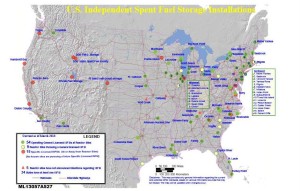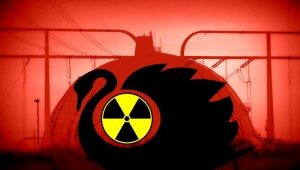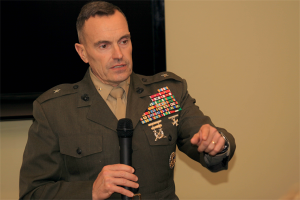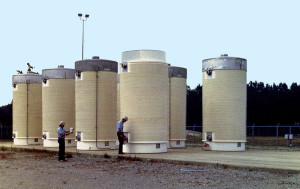Even before 9/11, Hirsch had warned of these dangers in a 1987 report for the Washington D.C.-based Nuclear Control Institute entitled The Truck Bomb and Insider Threats to Nuclear Facilities. “A traditional approach to the insider problem, the two-person rule (prohibiting unaccompanied presence in vital areas), has met with great resistance from industry and within the NRC,” the report said. “Even existing regulations designed to provide some measure of protection against insiders seem to be enforced and complied with inadequately. Violations of access controls are commonplace, and the small fines imposed when such violations are detected seem to offer little deterrent to repetition of the infractions.”
Two years after 9/11 Hirsch, along with nuclear safety engineer David Lochbaum and Nuclear Control Institute president Edwin Lyman issued a scathing indictment of the agency’s laissez-faire attitude in The NRC’s Dirty Little Secret. “The NRC has not required nuclear facilities to guard against an assault by more than three attackers–and never with the help of more than a single insider,” the article said in the May/June 2003 edition of the Bulletin of Atomic Scientists. “In addition, for purposes of planning security, the NRC assumed that the three attackers would act as a single team, armed with nothing more sophisticated than hand-held automatic rifles.”
 “But imagine if the public were told that more than 100 massive radiological weapons–‘dirty bombs’ on an incomprehensible scale–had been pre-emplaced in the United States, each capable of rendering an area the size of Pennsylvania uninhabitable for decades,” the piece said in closing. “Imagine further that the public learned that despite all the hype about homeland security, a powerful industry and its captured regulatory agency had succeeded in blocking security measures that would prevent those weapons from being used against the U.S. population. But one needn’t imagine–it’s the NRC’s latest dirty little secret.”
“But imagine if the public were told that more than 100 massive radiological weapons–‘dirty bombs’ on an incomprehensible scale–had been pre-emplaced in the United States, each capable of rendering an area the size of Pennsylvania uninhabitable for decades,” the piece said in closing. “Imagine further that the public learned that despite all the hype about homeland security, a powerful industry and its captured regulatory agency had succeeded in blocking security measures that would prevent those weapons from being used against the U.S. population. But one needn’t imagine–it’s the NRC’s latest dirty little secret.”
It’s no secret that the terrorist threat remains greater than ever as the closing of over 20 American embassies and consulates throughout the Middle East, Africa and East Asia as this summer attests. Continued drone strikes in Yemen and Pakistan, while effective in obliterating top terrorist operatives, have engendered deep hostility in the Muslim world. Potential military strikes against Syria led to it and its ally Iran making threats against America. And disaffected “homegrown” terrorists like the Boston bombers are likely lying in wait right now.
Our intelligence agencies have shown anything but intelligence. Edward Snowden released a treasure trove of National Security Agency information, including the revelations that the NSA has intercepted every communication of every American and spied intensely on even our closest allies, yet the all-seeing NSA managed to miss Snowden himself.
In its hubris, the nuclear industry and its federal overseers have already pre-placed terrorist targets throughout the country. All the intelligence gathering in the world can’t stop attacks on these targets and the Americans they will claim as casualties. The Boston bombings showed the impotence of the domestic spying effort other than to take mountains of useless information and stuff it into new NSA super-snooper buildings in Utah.
If common sense has taken leave of the federal government strategically, it can’t afford to be lost on tactical defense of the country. It has failed, however, when it comes to the both the tactical and strategic protections of our most vulnerable and exploitable weaknesses, America’s spent nuclear fuel pools.
EnviroReporter.com doesn’t expect SCE to take new observations about San Onofre’s acute vulnerabilities any more seriously than it did when the LA Weekly was told factual inconsistencies in 2001. The NRC doesn’t want to make industry pay for security it doesn’t think it needs – and of course wants to protect the industry from ever-growing public opinion that nuclear power simply isn’t safe. It looks bad.
Nevertheless, dismissing the need for immediate and robust measures to dry cask as much of SONGS spent nuclear fuel possible and then secure it as strongly as possible would be unwise at best, disastrous at worst.
Keeping SONGS Safe
Twelve years after 9/11 and two wars later, America’s strategic situation has changed substantially. The world is a much more dangerous place and in that time we have made more enemies than friends.
 Soft targets with big assets are obvious choices for terrorists. If a terrorist organization wanted to mount a force on force assault in this country, what place better than along the border with a virtual narco state that has the weaponry, manpower and connections to mount such an attack in the United States.
Soft targets with big assets are obvious choices for terrorists. If a terrorist organization wanted to mount a force on force assault in this country, what place better than along the border with a virtual narco state that has the weaponry, manpower and connections to mount such an attack in the United States.
Not only are the manpower, weapons and motivation available on both sides of the United States and Mexico border, the plant itself is a sitting black swan. SONGS has multiple serious security issues, any number of which could be exploited to catastrophic effects.
So serious is the nuclear site’s current security posture, including built in place barriers, that an immediate posting of Marines outside of SONGS is needed in order to even begin to address a broad range of tactical issues. That will probably not happen thanks to a nuclear industry that doesn’t see any problems and a regulatory bureaucracy which encourages unsafe practices even as it is charged with protecting America from a nuclear reactor or spent fuel pool disaster.
But the threat is all too real. It wouldn’t even take any training past aiming straight or knowing how to jump or cut through three fences. Such is the site setup of SONGS that a terrorist could inflict maximum damage on the ‘wet’ and ‘dry’ spent fuel rods and get away with it. No suicide bombers required.
The San Onofre Nuclear Generating Station might be the most exposed power plant in the nation. Hard on the heavily traveled San Diego Freeway, thousands of people pass within eyeshot of the SONGS Units 2 and 3’s spent fuel pools (SFPs) every day and night.
It’s no secret that they are there. In late November 2012, Southern California Edison announced that it had created a “virtual tour” which clearly points out the SFPs as does a SCE YouTube SONGS video.
A comprehensive analysis of the San Onofre Nuclear Generating Station’s weaknesses is much easier now than it was in 2001 when this reporter freelanced for the LA Weekly and first reported on SONGS. An Internet search shows just how vulnerable the plant is to terrorist attack. Google Earth, Google Maps and even Wikipedia provide detailed images of the layout and operation of SONGS. There is no end to the online information and resources on San Onofre and dozens of other nuclear reactors and their spent fuel pools (SFPs) across America.
Potential terrorists have access to this information too. That can’t be controlled. What can be controlled is action to assure our nuclear power plants, and especially their spent fuel pools, are protected like the gold at Fort Knox. A successful attack is so unacceptable in consequences that only a 100 percent sure protective envelope is necessary to clip unforeseen black swan events.
The supposed good guys in America’s 16 intelligence agencies may already know the information this series contains considering it has access to every single click this reporter and his readers have ever made for several years now if the leaked Snowden documents are of any measure. One piece of intelligence they may not know is that by removing the target, the terrorist has nothing to attack.
The billions of wasted taxpayer dollars waging this information war against its own people might be better spent making obvious targets hard. Not just virtually hard but real boots on the ground hard if need be. Reverse engineering the threat is the logical place to start, beginning with which targets are the softest in this country that have the biggest for the buck.
The softest targets are nuclear reactor spent fuel rods in cooling pools with dry casked radioactive spent fuel rods a not too close second. Nuclear reactors themselves are heavily fortified concrete enclosures and would require much heavier weaponry to successfully attack than the soft sites analyzed in this series.
SONGS’ Soft Spots
What San Onofre lacks in an effective defensive posture to successfully fend off terrorist attacks could be made right by use of the neighboring thousands of Marines on duty just down the Old Highway 101 road that runs along the eastern wall of SONGS between it and the San Diego Freeway. Unlike any other reactor and spent fuel pool complex in the country, San Onofre sits on Marine Corps land with 100,000 people on the base during daytime including 19,000 members of the First Marines Expeditionary Force. I MEF is made up of the 1st Marine Division, 3rd Marine Aircraft Wing and the 1st Marine Logistics Group.
 Recommending how to mitigate threats before exposing them is this series’ way of assuring the reader that the frightening attack scenarios exposed can be effectively dealt with. The weaknesses identified by EnviroReporter.com at San Onofre could be addressed immediately by Camp Pendleton commander Brigadier General Vincent A. Coglianese. With I MEF’s land, sea and air capabilities, and a concerted effort to unload San Onofre’s spent nuclear fuel rods into dry cask storage moved over to the eastern side of SONGS, the threat could be remedied in the short, medium and long term.
Recommending how to mitigate threats before exposing them is this series’ way of assuring the reader that the frightening attack scenarios exposed can be effectively dealt with. The weaknesses identified by EnviroReporter.com at San Onofre could be addressed immediately by Camp Pendleton commander Brigadier General Vincent A. Coglianese. With I MEF’s land, sea and air capabilities, and a concerted effort to unload San Onofre’s spent nuclear fuel rods into dry cask storage moved over to the eastern side of SONGS, the threat could be remedied in the short, medium and long term.
SONGS straddles the San Diego Freeway with the reactors and spent fuel pools on 84 acres along the Pacific including 600 feet of ocean frontage. Power lines cross the interstate and skirt the eastern part of the plant called the Mesa Complex covering 130 acres. Though it’s on a Marine base, this part of Camp Pendleton seemed lightly patrolled during EnviroReporter.com visits to the area and adjacent public beaches.
Indeed, the huge electric towers on the east side of Interstate 5 seem as vulnerable to sabotage as they were in 2001 with no barbed wire enclosures with ground sensors and cameras connected with Mesa Complex security. Dynamiting these towers near the plant or farther up in the immediate hills does not seem a likely terrorist endeavor. The electricity can be quickly restored and toppling towers do not make most Americans cower in fear.
Destroying spent fuel pools would. San Onofre’s SFPs are in two buildings defenseless to the kind of attack that can be only stopped before it gets started: missile attack. SONGS is a sitting black swan for this kind of terrorist strike which could be mounted from a wide choice of positions all easily accessible by the public.
Shoulder-fired rocket launchers are available on the streets of America. At no less than three guns-for-cash police buybacks recently, three rocket launchers showed up including a Stinger. These weapons are already in the hands of drug cartels which operate south of the Mexico-United States border 76 miles away. The U.S. has thwarted at least one Iranian plot to use Mexican cartel hit men on this side of the border to kill the Saudi Arabian ambassador, according to the Federal Bureau of Investigation.
The weapons and the men that could use them are all in place. So are the targets. It shouldn’t take pestering every American agency responsible for keeping us safe to see that there is a clear and present danger in SONGS’ proximity to heavily used roadways where a missile attack could be successfully launched close to the target SFPs. No other reactor in America is as vulnerable to such an attack.
Southern California Edison seemed oblivious to any kind of threat at all when it posted on YouTube the revealing San Onofre Nuclear Generating Station – Video Tour October 23, 2012. The video posting came in the wake of a serious sabotage event at SONGS, where coolant was poured into an emergency backup generator’s oil reserve for Unit 3. San Diego’s East County Magazine called SCE’s making public the video tour “troubling” in a November 30 article describing the sabotage.
 SONGS is squeezed in between the San Diego Freeway and the Pacific Ocean with little natural protection against a devastating missile attack against its SFPs or a catastrophic backpack plastic explosives strike against its Independent Spent Fuel Storage Installation (ISFSI) where dozens of dry casks sit lightly guarded. SCE’s video tour and that detailed SONGS Wikipedia photo from May 2012 leave little to the imagination when it comes to San Onofre’s security shortcomings. But SONGS could protect its assets in a way that other nuclear sites across the country don’t have because of occupying Marine Corps land.
SONGS is squeezed in between the San Diego Freeway and the Pacific Ocean with little natural protection against a devastating missile attack against its SFPs or a catastrophic backpack plastic explosives strike against its Independent Spent Fuel Storage Installation (ISFSI) where dozens of dry casks sit lightly guarded. SCE’s video tour and that detailed SONGS Wikipedia photo from May 2012 leave little to the imagination when it comes to San Onofre’s security shortcomings. But SONGS could protect its assets in a way that other nuclear sites across the country don’t have because of occupying Marine Corps land.
Missile attack on SFPs is not a new major concern. The Maryland-based Institute for Energy and Environmental Research released a March 23, 2010 paper signed by dozens of environmental and nuclear watchdog groups called Principles for Safeguarding Nuclear Waste at Reactors. The position paper advocated moving cooled spent fuel rods from SFPs to dry casks to be stored in hardened, onsite storage (HOSS) facilities to guard against attack.












This is a very important article with excellent analyisis of the security and safety situation at San Onofre nuclear plant and the nuclear industry in general.
Great work using open intelligence sources to point out the corruption at SCE/Nuclear Industry, that is putting the lives of everyone at risk simply for the satisfaction of greed and profits.
This in depth article deserves to be broadly disseminated, thank you for the work you have put into this informative piece.
Terrorists, psychos, wars and disgruntled crazy [furloughed] employees, not to mention mother nature, are extremely unpredictable.
Nuclear Power cannot, should not, operate with ‘unpredictable’ risks that carry with them the incalculable insidious destructive power to harm innocent life on such an unimaginable massive long term scale.
Seriously, I don’t understand why don’t people get this?
😉
In reading this article, some things become very clear. There are many reasons to shore up security at particularly vulnerable nuclear sites. For a private company, such as SCE, security is not their top priority. A private company’s top priority is, not surprisingly, profit. Security is a cost, and costs subtract from profit. The NRC understands this, and makes security scenarios that will not cost nuclear plant operators too much money. The article also references Osama Bin Laden and his thinking on nuclear targets. I was unaware that Osama Bin Laden recommended against such targets (at that time). That is very interesting. Now that the US has removed Osama Bin Laden from the equation, the US may have removed one of the individuals who provided an argument against thinking of nuclear sites as targets. Feeling more uneasy now? You should. Michael Collins has painted a worrisome picture of the future. Specific vulnerabilities, methods of attack, and weapons that could be used, are all very frightening. I suspect the terrorists don’t really need any help thinking up ways to attack a nuclear site. The real danger lies more fundamentally within the mindset of the terrorists. Do they understand such an attack could “get out of hand”, producing consequences that could spiral out of control? Consequences that would not be in the terrorists best interests? From reading this article, I think Osama understood that. But Osama is no longer there to prevent the unthinkable. That “mindset” gateway to nuclear terrorism may now be open. That is what should worry us most. Thank you Michael for your article. Very thought provoking. Very scary actually. I won’t be sleeping as well tonight. America shouldn’t either.